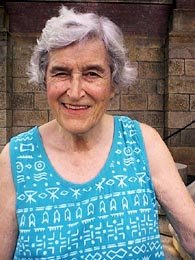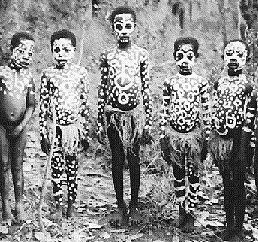Anthropologist Edith Turner insists that spirit stuff is real because, during the frenzied climax of a lengthy Ndembu ritual in Zambia, she saw it come out of the patient’s body, and she observed it become a human tooth — an ihamba, a dead hunter’s tooth, which had been wandering around inside the patient, causing her severe pain. As Turner writes, at the climactic point of the ritual, the healer, named Singleton,
pressed Meru’s back, guiding and leading out the tooth – Meru’s face in a grin of tranced passion, her back quivering rapidly. Suddenly Meru raised her arm, stretched it in liberation, and I saw with my own eyes a giant thing emerging out of the flesh of her back. It was a large gray blob about six inches across, opaque and something between solid and smoke: I was amazed, delighted. I still laugh with glee at the realization of having seen it, the ihamba, and so big! Everyone was hooting, and we were all jumping with triumph. The gray thing was actually out there, visible, and you could see Singleton’s hands working and scrabbling on the back. And then it was there no more. Singleton had whatever it was in his pouch, pressing it in with his other hand.
Turner gives substantially the same account in another article, except the spirit stuff is there described as “a deep gray opaque thing emerging as a sphere.”
Now there is a lot happening at once here. There is the “bellow of the drums.” Turner herself is crying, there are tears in her eyes, her eyes are “stabbed with pain.” Turner is clapping and jumping along with the crowd — clapping hard, she says. The patient is quivering, stretching out her arm; people are shouting and jumping up and down; the healer is touching the patient’s back, his hands pressing, guiding, leading, working, and scrabbling. Suddenly something is in his pouch; he has caught the ihamba.
There is more to the story. Singleton quickly transferred the contents of the pouch to a receiving can, which had a castor oil leaf and mukosu bark lid, and which contained a nest of root fragments, water, and blood from a rooster’s claw. He carried the can into a hut, set it down on the floor, held up his hands and said, “See, I have nothing in them.” Then he squatted down and dredged a long time in the bloody mixture. At length he drew out “an old tooth, a molar, natural size, ordinary and concrete, with a dark root and one side sheared off as if by an ax.” It was the ihamba. Retrieving and displaying the tooth from the receiving can is apparently an important part of the ritual.
 |
| Anthropologist Edith Turner |
Of course, Turner has no way of knowing when the tooth was actually put into the bloody mixture. She assumes it was when Singleton extracted the tooth from the patient, because that is when she thought she saw him do it. But it could have been when Singleton, unsupervised, carried the can into the hut; it could have been when he was poking around inside the can. Indeed, the tooth could have been put inside the bloody mixture — which Turner never examined — before the ritual even began. There is no way to know. But why in the world would Singleton specifically deny that he was performing any sleight-of-hand before pulling the tooth out of the can?
That evening, Singleton said, “The thing we saw, we were five.” Singleton was counting the five doctors, of which Turner was one. Turner took this as a statement that the doctors too had seen a “thing,” meaning something like her gray blob; she does not consider that he is talking about the tooth he pulled from the can. Indeed, when Turner described to Singleton what she had seen — the gray blob of “spirit matter” — the healer made no comment. He did not “describe what he had seen” or “give any details about what he actually saw.“ Turner herself “was in no mood to become analytical so did not push the matter further.” So there is nothing to indicate whether Turner’s apprehension of a gray blob is consistent or inconsistent with Ndembu cultural notions of what an extracted ihamba tooth is supposed to look like, although one may guess, since it is a tooth that is pulled from the receiving can, that it is supposed to look like a tooth.
Turner considers, and rejects, the idea that some sort of sleight-of-hand might be involved in all this. She says that there was nothing in her audio tapes that hinted of duplicity, yet it is unclear how an audio tape would reveal conjuring. She does not discuss the possibility that, in the intense excitement of the ritual, out of Singleton’s skill as a performer, while she was moved emotionally, clapping hard with tear-filled eyes, she saw something out of her own cultural tradition, something smoky and ectoplasmic, that had symbolic significance to her, rather than to her hosts.
 |
| Ndembu boys prepared for an initiation ceremony |
There is a methodological point to be made here. Turner insists that, because she saw spirit stuff and believed in its reality, she was uniquely able to experience Ndembu culture “from within.” Yet she has no idea whether or not Ndembu culture considers an ihamba tooth to look like a gray blob when it is extracted from the body. Speaking of the other participants in the ritual, she says, “I could not ascertain if what they saw looked exactly like what I saw.” She made no inquiry about what they did see, and did not pursue why, once she told them what she saw, they — perhaps, one thinks, out of politeness — did not want to tell her.
Turner cites, with approval, Michael Harner’s distinction between the spiritual essence of an illness, which may appear, in the “shamanic state of consciousness,” to be, say, a spider, and its manifestation, in the physical plane, as, say, a “plant power object” — some twigs, say, which the shaman may hide in the mouth and then display to the patient and audience, who are in the “ordinary state of consciousness,” as evidence of the extraction. But the quote from Harner misses the point. Harner — and many others, such as anthropologist Marvin Harris — would agree that the tooth pulled from the can had symbolic significance as a warrant of the shaman’s skill, of the mystery underlying the healing process, and may easily have been produced by sleight-of-hand. But Turner is not talking about the tooth. She is talking about her own joyous and transformative vision of the gray spirit stuff.
This is the paradox of participant observation — how to participate and observe at the same time. We certainly cannot be invisible. As Dennis Tedlock puts it, “the more a fieldworker knows and is known, the less that fieldworker can avoid joining the action.” At the same time, the host culture is not a unity. The idea that an anthropologist can come — somehow — to see the world through the eyes of the host culture assumes that cultural insiders are a single collective entity, that all insiders see the same thing, and that all participants feel, experience, and assign an identical, singular meaning to a particular event.
Thus, the term participant observation has something of the oxymoronic about it. Pierre Bourdieu comes right out and calls it a contradiction in terms — “as anyone who has tried to do it will have confirmed in practice.” Bourdieu believes that it leads to the worst of two possible worlds: “One cannot live the belief associated with profoundly different conditions of existence,… still less give others the means of reliving it by the sheer power of discourse.” And he concludes: “Those who want to believe with the beliefs of others grasp neither the objective truth nor the subjective experience of belief.”
And if we sincerely seek to understand the spiritual realities of another culture, where does that leave us? When does our experience become their experience?

- Previous Post: Sacred Justice, Part 1
- Next Post: Nip/Tuck
- More Articles Related to: Indigenous Culture, Shamanism



Thinking about your last question – Edith Turner’s vision left her in a highly spiritualized state, but a world apart, as you suggest. The power of both the shaman and the ritual allowed her to drop her self-identity long enough to peep into their world and breathe their psychic breath. Her misinterpertation was surely due to her unfamiliarity with the Ndembu’s own somatic culture, but at least she gained an opportunity to explore it within their somatic and emotional realms. It’s axiomatic to say that most fieldworkers don’t get that far. In fact, I like to think that many of them do, but end up suppressing their experience, surely in publications and maybe even to themselves, in the name of of the “scientific” status of their professions. This is unfortunate, because one can in fact be responsible to one’s own experience and to scientific standards. If it were not for Edith’s experience – and misunderstanding – we would have never understood even this much of what the shaman did. Good work, Steve!